I built this from several sets of plans. The most important accessory I own. It was very easy to build and a joy to use. Combine the comfort of the observing chair, binoviewers and eq platform and I can stare at Mars for 3 hours without fatigue. Life is good.
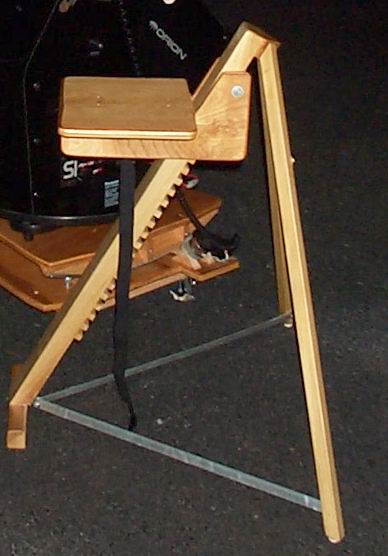
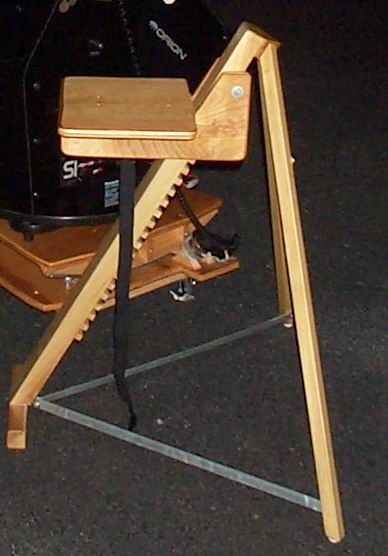
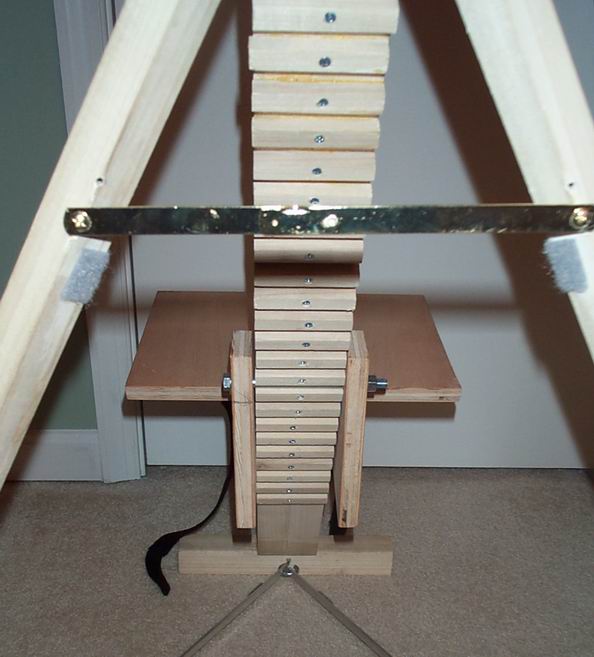
Well, I had decided to buy Jim Fly’s plans and hardware so I could build a Catsperch Pro. My old chair was too short for the new Starmaster, so this seemed like a good solution. Here are the pics:
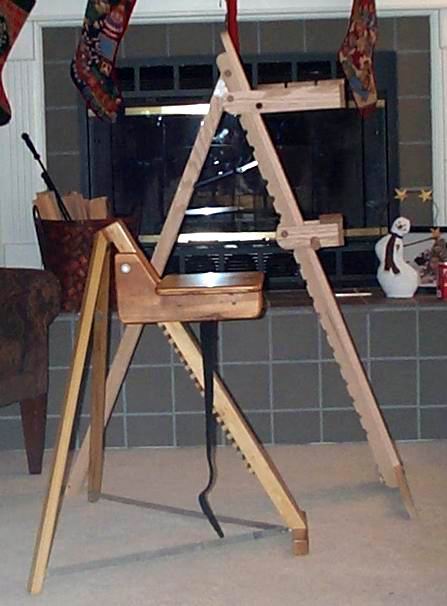
Buying the plans is a great time saver. I am good at cutting and tracing 😉 This is a great design that holds my 220 lbs with
aplomb. Plans and hardware were $40 and the wood was $70. Took 8 hours to assemble and I probably have another 3-4 hours to sand and finish. Unless Jim is getting a huge discount on wood, his kit is a bargain. I just didn’t want to wait 15 months.
I cut all the wood with a $24.99 Skil jig saw with a 10 tooth per inch blade. Then I shaped/sanded it with my $29.99 Craftsman belt sander with 50 grit paper on it. Holes were drilled with my $49 DeWalt corded 3/8″ drill. Every part is unique and does not exactly match any measurement found on the CAD drawings 😉 Even so, it turned out very nice and I’m proud to be the owner. Fancy tools are NOT required to get a fine looking chair (but I won’t turn down any donations 😉
My old chair was a cross between a Denver, a catsperch and my own ideas. I made it out of poplar instead of oak. It is great for it’s height, but would not do for a taller chair.
So, I’ll be happy for tonight’s Saturn opposition. Clear skies, 11″ Zambuto Starmaster, eq platform, binoviewers and AT LAST, a taller observing chair. Never again will I have to go so long and observe while standing.
Many heartfelt thanks to Jim Fly for the speedy delivery of the plans and parts. I know there is enough information out there that I didn’t need your stuff to build this, but the cut and trace templates were a Godsend. That alone saved me countless hours of cursing and wasted lumber.
My first chair was already becoming vertically challenged with my XT10 sitting on an eq platform which was on wheels. When I got the Starmaster, it was woefully inadequate. So, I started searching for a suitable replacement. A guy in my club had one of Jim Fly’s Catsperch chairs (not the Pro version) and it looked to be just the ticket. I was gonna build the Catsperch Pro version from gouge I found on the internet, but I decided to support Jim and ordered his plans and hardware package:
https://www.catseyecollimation.com/chairprods.html#PLANS
It arrived Xmas eve, but I was on holiday, so I just started building it yesterday. Finished it except for the urethane today. A fantastic chair.
As you can see, it is considerably taller. It holds my 220lbs frame with no issues. This is a perfect solution for me. The plans with hardware cost $49 with shipping. This made the job incredibly easy. Although certainly not required, the hardware package saved me 10 trips to the dreaded pit of despair that is called Lowes. The cut and trace patterns were a God send and saved me more trips to Lowes for replacement lumber. The lumber is all red oak and cost $70 at the aforementioned Hades of Hardware (can you tell I love Lowes?).
This is an easy kit to build and requires no special tools. I used a cheapo Skil jigsaw to cut out everything. Made for some interesting shapes 😉 I used a cheapo belt sander to fix the zig zags in the cuts. The only other tool required is a drill. Good thing, too, as that’s all the tools I have.
So far, I’ve put in 10 hours on it. All that’s left is to put the finish on, but that will have to wait until some clouds roll in. I am very pleased with this chair and Jim Fly. A very nice fellow and a great American. My first chair cost about $30 in materials and took about the same amount of time. But this Catsperch is a lot nicer.
I highly recommend it to anyone considering an observing chair.
A FEW MODIFICATIONS
I was very happy with the Catsperch Pro as it was, but the wide front foot (28″) was getting in the way a bit. My first mod was to make the front foot 13.5″ wide and put the 28″ foot on the back leg. This was very stable and I was going to leave it like that.
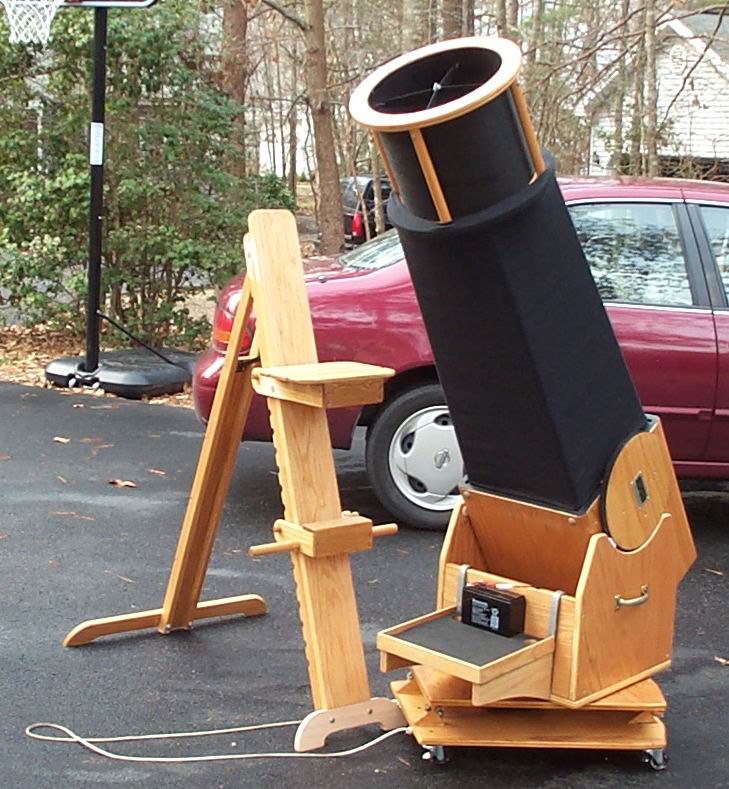
But, a right nice fellow suggested just leaving the front foot 5.5″ wide like the front leg and use the 28″ foot on the back for stability. I tried this and it worked great.
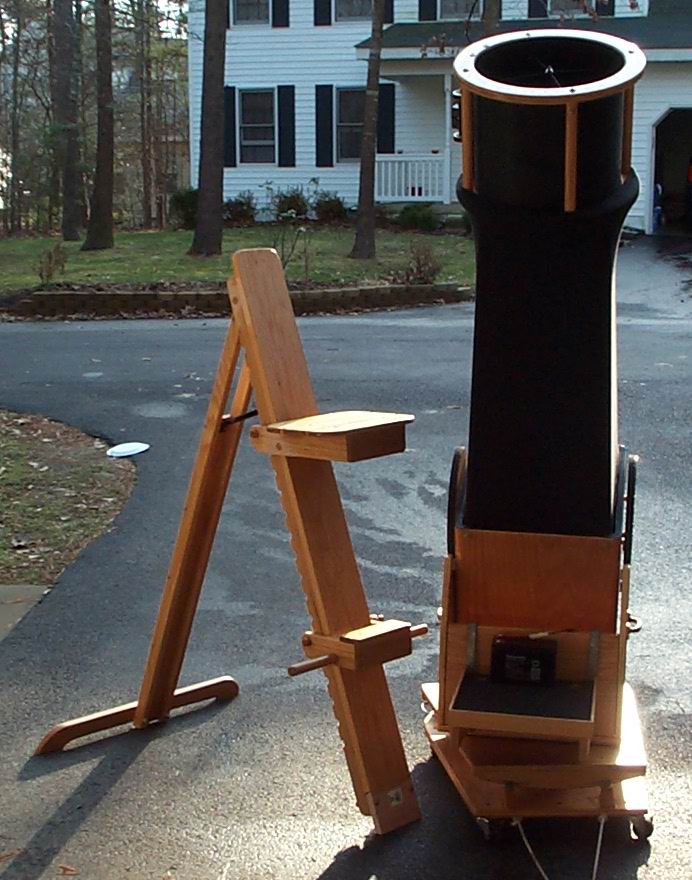
As you can see in the picture, this allows me to get the Catsperch Pro right up to the eq platform. This will prove very useful.
This shows the front foot. I just screwed and glued it to the side rails. The extra holes in the middle are where the carriage bolts were that originally held it on. I decided to permanently attach the front foot as it was only as wide as the front leg. This had the added benefit of allowing me to slide the footrest and seat on and off without having to remove the dowels that hold them on. Less parts to drop! I really think this mod is a great way to go.
I was looking at this just now and decided the best way to implement this is with a longer front board. This will eliminate the added piece at the bottom. Just make the front board 3.5″ longer (there is enough left over from the 1x6x6). This would make for a much nicer finished product and also stronger.
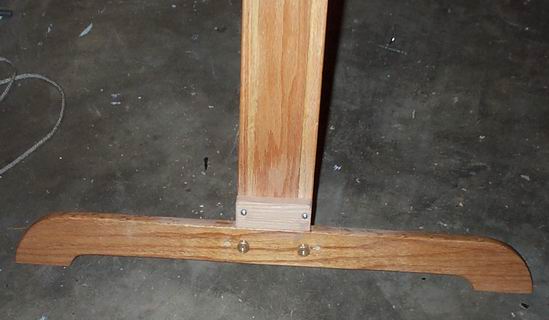
Here, I added a reinforcing block above the back foot. The great part of Jim Fly’s design with the foot on the front was the bracing that the front leg panel provided for the foot. Even if the carriage bolts are not completely tight, the front foot is quite effective at stabilizing the Catsperch. Since I moved the wide front foot the the rear, I found that the carriage bolts needed to be very tight (tighter than hand tight) to provide proper stability. Adding this block fixed the problem. The design is quite ingenious in that the weight of the observer adds to the stability. Just get the carriage bolts hand tight and you will not fall over.
The chair still folds up completely (notice the knurled thumb knobs on the carriage bolts are on the outside now). The rear foot removes just as it did when it was on the front. And, the footrest and seat can just slide off the front leg. I am going to finish sanding, filling extra holes and getting the new parts urethaned and then I’ll be done. Great chair!
MORE ADDITIONS
I have had a chance to use the chair many times and I am extremely pleased with it. Putting the large foot on the back has proven to be the icing on the cake. I have made one addition that is simply fantastic. I added a heated seat pad! Oh my, does that make the cold winter observing sessions a lot easier on the bum.
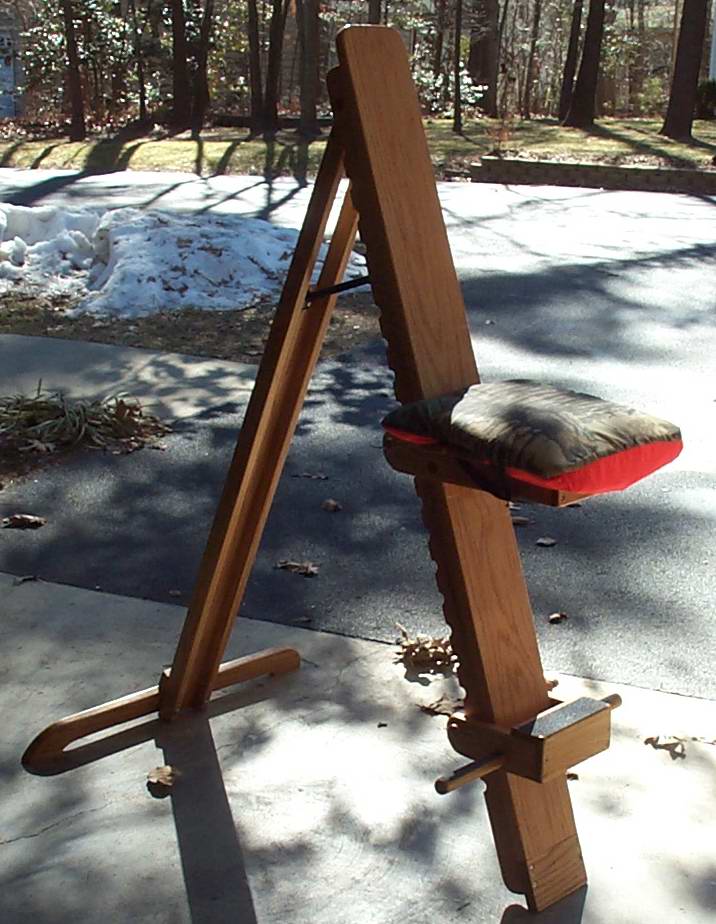
The pad has a Microcore (TM) insert in it that can be heated in the microwave. I gotta tell ya, I’m not a wimpy guy, but having a heated seat is the cat’s meow. The one on my chair right now is on loan from the neighbors. I have a royal blue one on the way.
Here’s a picture of how I attached it:
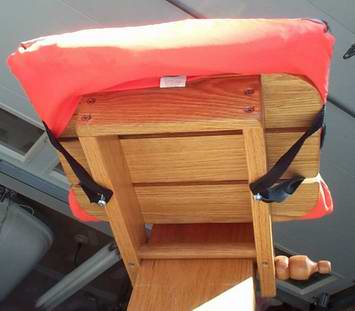
Another nice feature of this chair was discovered on a wonderful night about a week ago. The seeing was very good and the night was balmy (42 deg F) for February in Maryland. I was looking at Saturn at 545x with the Starmaster 11EL and binoviewers. I also have an equatorial platform.
I must have sounded excited because all the neighbors were coming out and wanting to have a look. I had at least 15 people stop by for a look ranging in age from 6 to 76. Saturn was in a position that put the binoviewers at about 4 ft 6 in off the ground. All of the adults could see just fine, but the younger kids needed some help. Normally I have a step stool out for them, but tonight I used the Catsperch. The seat goes up high enough to allow the children to sit while observing. This prevents a lot of grabbing that usually results in the scope moving off target, especially at 545x. I had to lift the kids up on the seat, but once up there, the oohs, ahhs and wows were very satisfying.
The extra height capability afforded by this design is what made it all possible. The Catsperch is one fantastic observing chair.
